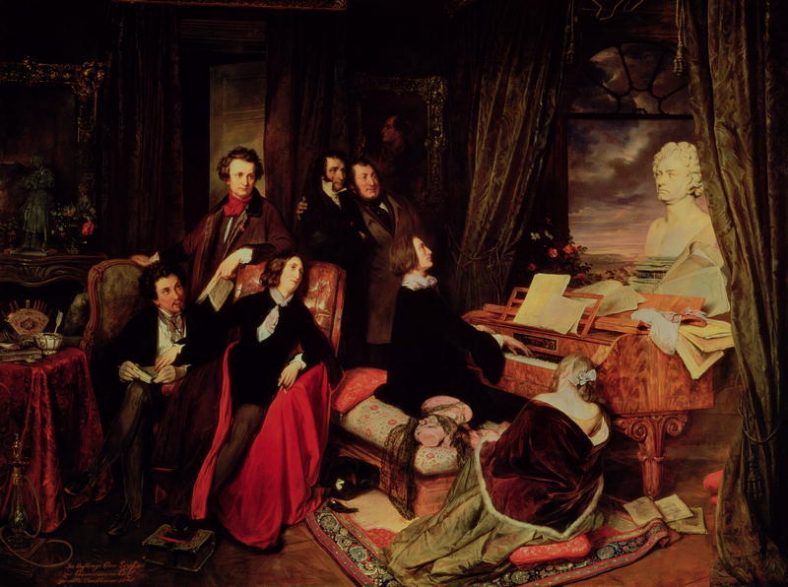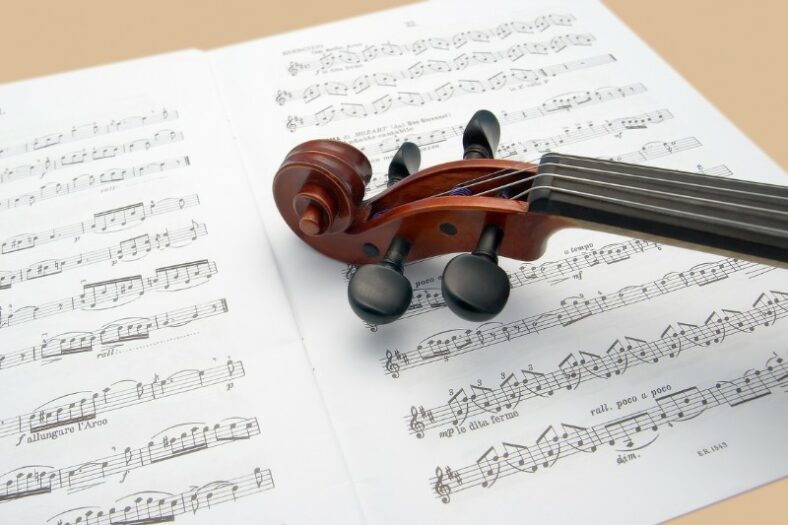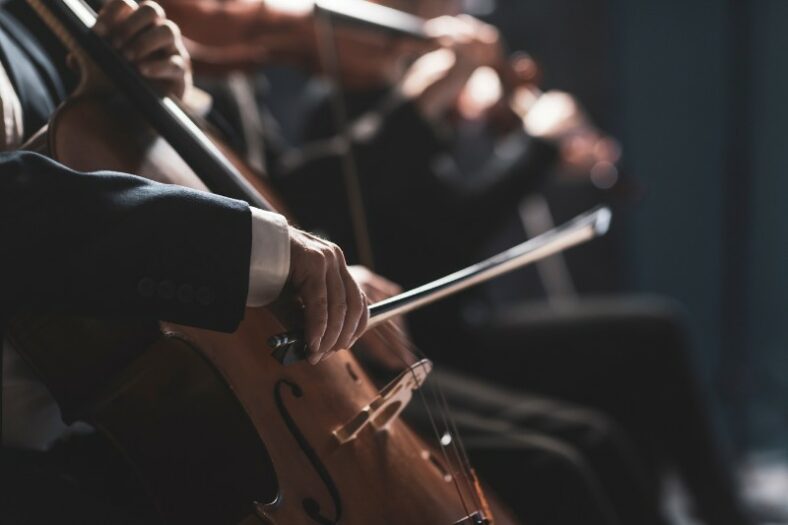Characteristics of Romantic Period Music

The Romantic Period lasted from 1850 to 1900. Characteristics of this period are expanding forms, increased dissonance, program music, organic unity, and concert life. The expression of more individual and emotional experiences was a given during this period.
Composers didn’t reuse their material in new compositions for the first time. The Baroque and Classical periods were ideal periods for this practice. This allowed composers to write massive amounts of music quickly.
Each composer of the Romantic period brought life to their musical narratives. They did so by expressing unique emotions through free forms, dissonance, and expanded dynamics. At the time, composers were at risk of being disrespected if their material wasn’t new and original. This was due to an increasing emphasis on individualism and the individual’s emotions.
Contents
At A Glance
- Characteristics of the Romantic period music are expanding forms, increased dissonance, program music, organic unity, and concert life.
- Some notable Romantic period composers include Beethoven, Tchaikovsky, Liszt, Wagner, and Verdi.
- Instruments used in Romantic period music:
Strings – violin, viola, violoncello, contrabass.
Woodwind – flutes and piccolo, oboe, clarinet, bassoon, contrabassoon.
Brass – trumpets, trombones, French horns, tuba.
Percussion – xylophone, gong, cymbals, bells, triangles, chimes.
Characteristics of Romantic Period Music

1. Expanding Forms
Expanding forms were vital in Romantic Period music. This included Nocturne, Romance, Rhapsody, Etude, The Concert Ouverture, Polonaise, Arabesque, and Lieder.
Before this period, some new forms had already started to take shape and become popular. A few of these forms were altered or modified by Romantic composers to make them more subjective.
In the Romantic era, some of the things that were popular in the Classical era were still popular. Individualist and subjective language of the Romantic period created new forms of music. Composers were looking for new ways to express themselves, their experiences, emotions, etc.
- Nocturnes are musical compositions that reflect the atmosphere and feelings of the night. When it comes to nighttime, there is no better time to compose a piece of music than during this time of day.
- A brief, expressive piece for piano called “Romance”. Alternatively, a solo instrument might be accompanied by a keyboard accompaniment. Musically speaking, this is the equivalent of poetry’s “personal feeling and expression”. In music, it refers to the same thing.
- Everything in a Rhapsody is about contrasts. High and low, light and dark, loud and gentle, joyful and sorrowful. It tells a journey, a story. A musical Rhapsody is a collection of musical ideas merged into an undetermined period with no discernible pattern.
- Etude is a type of composition that was originally a study or technical exercise. It has now evolved into a musically coherent work that explores a pleasing technical challenge.
- Based on the manner of romantic opera openings, The Concert Overture evolved into classical sonata forms or symphonic poem forms.
- In Romantic period music, Polonaise is a variety of Polish folk dances that began to spread over Europe. Additionally, the French decided to gather them all together during this period.
- Musically speaking, Arabesque is a piece of ornamental music meant to evoke the style of Arabic architecture.
- Lieder refers to German songs, that originated from poetry and were performed by one singer and piano only. It differs in polyphonic interaction created when two musicians share the task of expressing a song’s lyrical essence.
2. Increased Dissonance
Dissonance increased in a short period in the Romantic music period. The 20th was close and this characteristic is even more impressive when you compare it with the previous eras.
The composers of the Renaissance and Baroque periods used more distant keys than classical composers. There was a greater reliance on harmonic harmony than in previous eras.
Composers used dissonance to enhance the expressiveness of their music. For greater emotional impact, they began using chromatic notes in their chords and melodies. The result was consonant chords, which make the music feel back in harmony again.
Composers enlarged chords by adding new notes to existing chords. In certain cases, the music became confusing in tone. During the twentieth century, this was refined even more.
3. Program Music
Program music is a composition written to accompany a certain story. It’s designed to elicit more musical thoughts or pictures in the minds of listeners. This was done by musically expressing a scene, topic, event, or textual material.
Typically, program music describes visual images or tells a story. A musical piece on its own, without a program, is called absolute music. It wasn’t until the Romantic period that orchestral program music became a popular kind of descriptive music.
Music was used to express the story or inspiration, but still, this definition is a bit confusing. In a way, it’s hard to talk about music that doesn’t contain any sort of material, whether it’s feelings, visuals, or memories.
Romantic period composers used short melodic ideas. They transformed them and kept on representing the original idea at the same time. Additionally, instruments represent something in nature or imitate a particular noise. This made it possible to use the dynamics to the extreme limits.
4. Organic Unity
It was a common practice among composers to connect the movements of their compositions through an organic unity.
Organic unity is a way to make a bond between the movements and sections of the movements. The logic was somewhat simple. Repeating a motif that we hear at the beginning of the composition, each time there is a transition.
In German, the term is “leitmotif”, and in French, “idée fixe”. In many Romantic-period symphonies, and sonatas you may hear these unifying themes recurring.
5. Concert Life
Public concerts became popular throughout the Classical period. They rose even more in the early decades of the nineteenth century. The result was a flourishing concert scene during the Romantic period.
There were several concerts organized by the government and the music community then. Spectacular concert halls came about to handle orchestras and enormous crowds.
Composers could make money by having their pieces played and published at public concerts. Because then, they were writing for nobles or churches. Public concerts also took on many forms for various types of concert events.
Notable Romantic Period Composers

Many composers during this period drew influence from the great Beethoven, especially since some of his last works laid the foundation for early Romanticism. Composers such as Franz Schubert, Robert Schumann, and Hector Berlioz also played a part in being the inspiration for this period.
Many composers shined during the Romantic period such as Clara Schumann, Felix Mendelssohn, Johannes Brahms, and Chopin, but the following are considered among the best of this period:
- Ludwig van Beethoven. Although Beethoven was a Classical period composer, some of his last pieces of music like his string quartets and Symphony No. 9 are considered the birth of early Romanticism.
- Pyotr Ilyich Tchaikovsky. The first Russian composer to leave a lasting impression, Tchaikovsky wrote the famous “Swan Lake”, “The Nutcracker”, “Romeo and Juliet”, and the opera “Eugene Onegin”.
- Franz Liszt. Liszt was one of the most influential and successful composers of the Romantic period. He brought new life to this period of music with his innovations in harmony, thematic transformation, and symphonic poem.
- Richard Wagner. A prominent composer, theatre director, and conductor hailing from Germany, Wagner was one of the key composers during the Romantic movement. He frequently used rich harmonies, elaborate leitmotifs, and complex textures.
- Giuseppe Verdi. Verdi was an Italian romantic period composer who dominated the Italian opera at the time. His most influential pieces include “Aida”, “Requiem”, “Otello”, and “Falstaff”, all of which pushed the boundaries and contributed to the sound of the Romantic period.
Instruments used in Romantique Period Music
The piano’s octave range grew from 4 to 5 octaves and finally, to the 7-octave range it has today. Throughout the Romantic period, the composers took full use of this newfound flexibility.
Steel and cast iron-based pianos were also built to be more durable, allowing them to play at a higher volume level.
The romantic period represents larger orchestras using rubato. This is speeding up and slowing down the music (rhythm and tempo changes), to make interesting harmonies and changes in the music. Expanding the instrumentation in their pieces was a common goal for composers. This involved expanding the size of the orchestra.
A lot of instruments were used in the orchestra during this time. This was a big deal because the orchestra took the shape that we still see when we go to a concert hall or a theater.
- Strings – violin, viola, violoncello, contrabass.
- The woodwind instruments – flutes and piccolo, oboe and English horn, clarinet and bass clarinet, bassoon, and contrabassoon.
- Brass instruments – trumpets, trombones, French horns, and tuba.
- A full set of percussion instruments
Summary
Romanticism and individualism are the basic, ideal foundations of Romantic period music. For making music in the most personal way the musical forms expand. The use of dissonances increased the potential for expression. Program music or Programmatic music uses music as a narrator. Organic unity keeps the chapters of the whole story in a union. As a result, people get eager to hear those stories at big public concert events.





